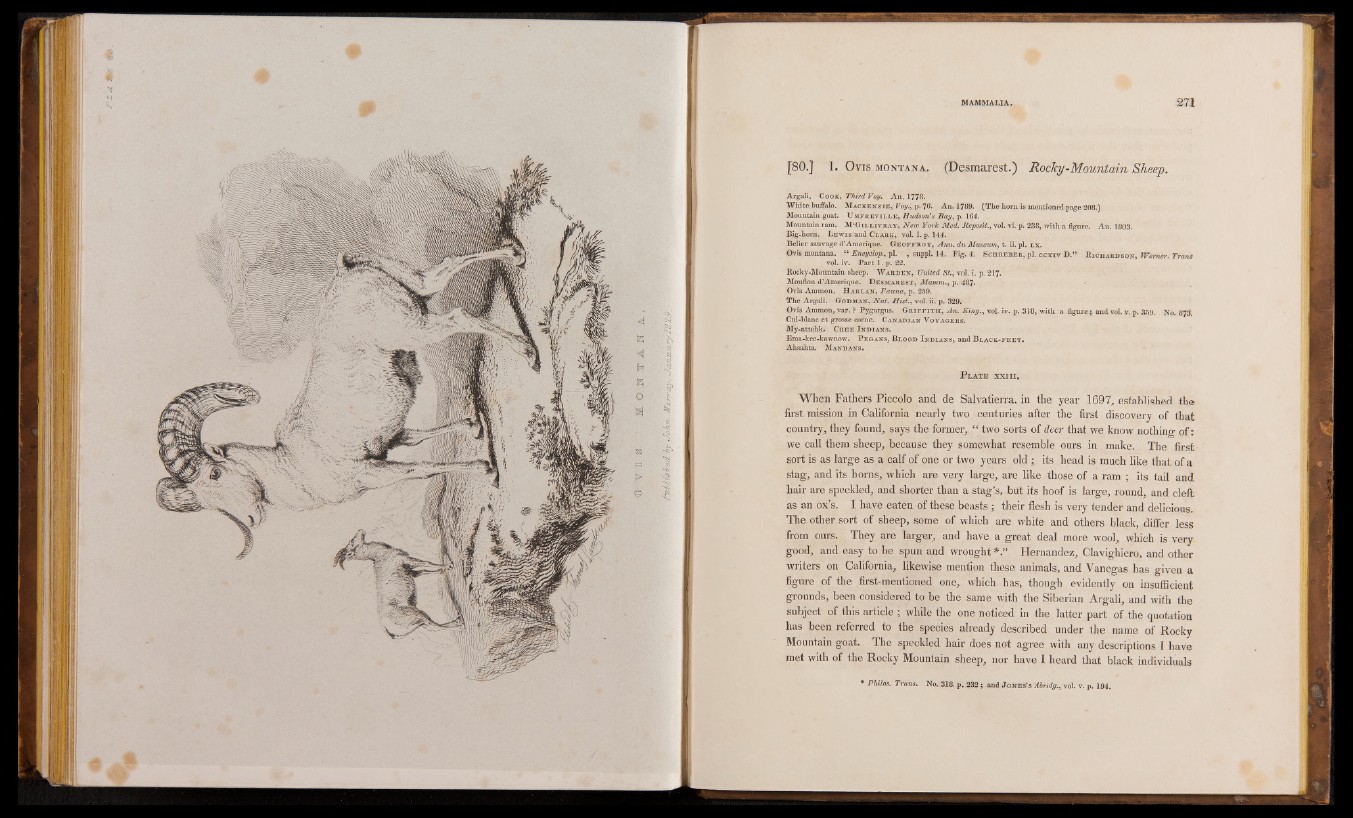
Ma-blished. by Söhn, M u rra y, J^an'a.a.ry 1 8 Z S
[80.] 1. Ovis Mo n t a n a . (Desmarest.) Rocky-Mountain Sheep.
Argali. Cook, Third Voy. An. 1778.
White buffalo. Mackenzie, Voy., p. 76. An. 1789. (The horn is mentioned page 208.)
Mountain goat. Umfreville, Hudson's Bay, p. 164.
Mountain ram. M‘Gillivray, New York Med. Reposit., vol. vi. p. 238, with a figure. An. 1803.
Big-horn. Lewis and Clark, vol. i. p. 144.
Belier sauvage d’Amerique. Geoffroy, Ann. du Museum, t. ii. pi. lx.
Ovis montana. “ Encyclop., pi. ' ,. suppl. 14. Fig. 4. Schreber, pi. c c x iv D.” Richardson, Werner. Trane
vpl. iv. Part 1. p. 22.
Rocky-Mountain sheep. Warden, United St., vol. i. p. 217.
Mouflon d’Amerique. Desmarest, Mamm., p. 487.
Ovis Ammon. Harlan, Fauna, p. 259.
The Argali. Godman, Nat. Hist., vol. ii. p. 329.
Ovis Ammon, var. ? Pygargus. Griffith, An. King., vol. iv. p. 318, with a figure j and vol. v. p. 359. No. 873.
Cul-blanc et grosse corne. Canadian Voyagers.
My-attehk. Cree Indians.
Ema-kee-kawnow. Pegans, Blood Indians, and Black-feet.
Ahsahta. Mandans.
P late x x i i i .
When Fathers Piccolo and de Salvatierra, in the year 1697, established the
first mission in California nearly two centuries after the first discovery of that
country, they found, says the former, " two sorts of deer that we know nothing of:
we call them sheep, because they somewhat resemble ours in make. The first
sort is as large as a calf of one or two years old ; its head is much like that of a
stag, and its horns, which are very large, are like those of a ram ; its tail and
hair are speckled, and shorter than a stag’s, but its hoof is large, round, and cleft
as an ox’s, I have eaten of these beasts ; their flesh is very tender and delicious.
The other sort of sheep, some of which are white and others black, differ less
from ours. They are larger, and have a great deal more wool, which is very
good, and easy to be spun and wrought Hernandez, Clavighiero, and other
writers on California, likewise mention these animals, and Vanegas has given a
figure of the first-mentioned one, which has, though evidently on insufficient
grounds, been considered to be the same with the Siberian Argali, and with the
subject of this article ; while the one noticed in the latter part of the quotation
has been referred to the species already described under the name of Rocky
Mountain goat. The speckled hair does not agree with any descriptions I have
met with of the Rocky Mountain sheep, nor have I heard that black individuals *
* Philos. Trans. No. 318. p. 232; and J ones’s Abridg., vol. v. p. 194.